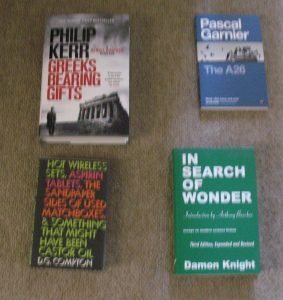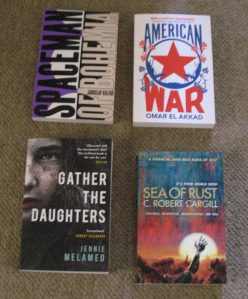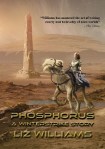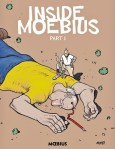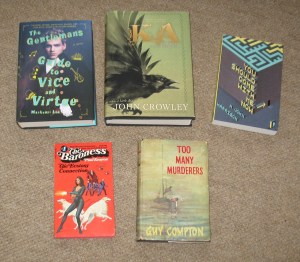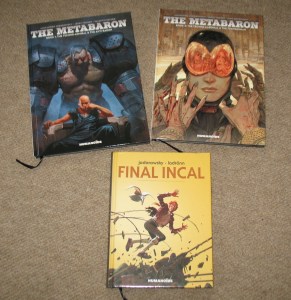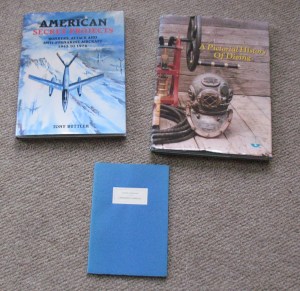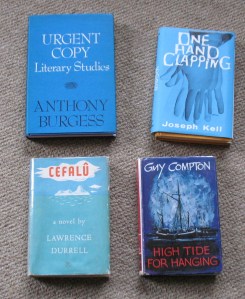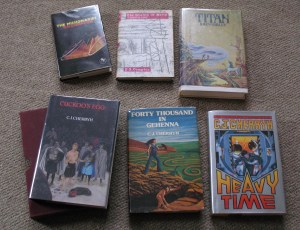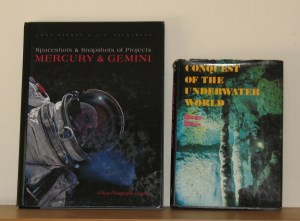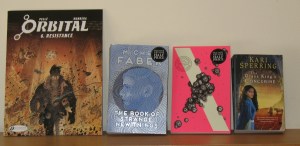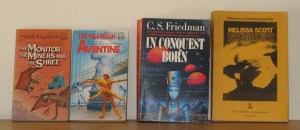100 books that “shaped your world”… Sounds easy enough. Until you start thinking about titles. I could have just banged out a list, and not worry about whether some of the books actually deserved to be on it. But no, I had to put together an annotated list – which meant I had to give a reason why each book made my 100. You can find the earlier parts of my list at: part 1, part 2, part 3 and part 4. But I’ve also included a full list of the 100 Books That Shaped My World at the end of this post. Because this is the last post on the topic, and it covers…
The 2010s
I spent all but the last ten months of the decade living in South Yorkshire, buying far too many books online and from local charity shops. It all got a bit out of hand. When I put everything in storage and moved, I filled 85 boxes, mostly with books. I also sold about 15 boxes of books, and gave away close on 100 paperbacks. The good thing about this was it actually financed my move north. Even so, I was still a little surprised at how much I’d amassed.
I did, however, read plenty of books this decade. Just shy of 1500, in fact. My reading tastes also changed. As the 1990s and 2000s had progressed, I’d found myself reading more and more “literary” fiction, although science fiction still formed the bulk of my reading. During the 2010s, I started reading more British postwar fiction, and treasuring the prose of a number of such writers.
But I wasn’t just drifting toward fiction that wasn’t genre, I was also starting to be put off by current genre writing. Twenty-first century science fiction, especially US sf, began to privilege sentiment over rigour. And then there was the somewhat florid prose, and the over-use of metaphors in an attempt to add invention to over-familiar sf tropes. Changes in the publishing industry also meant editors chased debuts – because at least debuts weren’t “categorically killers”… yet – and the decline of marketing budgets pushed most of the promotion online and onto the authors themselves, and reviewers, bloggers, fans and readers. Which made it all tribal as fuck. The growing dominance of fantasy also limited the science fiction considered commercially viable, and in recent years several popular works have melded the two genres.
Of course, writers whose works I liked and admired were still published, and I discovered new writers whose books I liked and admired, and, even though I’ve been reading science fiction for close on 45 years, there’s still plenty of old science fiction for me to explore (even if its appeal is often somewhat limited).
This is, of course, a purely personal perspective. The science fiction genre has changed – this is hardly surprising – not only artistically but also in the way the publishing industry treats it. Some of those changes have worked for me, some haven’t. But it’s probably telling that only three category sf books from the 2010s appear in the list below, and one of those is in a negative capacity.
 Lady Chatterley’s Lover, DH Lawrence (1928). My father had been a big fan of Lawrence’s fiction for much of his life, even going so far as to drag my mother to Taos to visit Lawrence’s shrine during a visit to the US. I think perhaps because of my father’s reverence for Lawrence, and what I imagined 1920s prose to be like, I sort of avoided reading him. But for some reason I decided to give Lady Chatterley’s Lover a go, and immediately fell in love with the book and Lawrence’s prose. So much so, in fact, that I tracked down Lawrence’s other books. But even that wasn’t enough, and I spent a long time hunting down copies published in the 1970s by Penguin, with white covers and Lawrence’s name in orange, as shown to the left. I now have twenty-eight of them. I’m still working my way through Lawrence’s oeuvre.
Lady Chatterley’s Lover, DH Lawrence (1928). My father had been a big fan of Lawrence’s fiction for much of his life, even going so far as to drag my mother to Taos to visit Lawrence’s shrine during a visit to the US. I think perhaps because of my father’s reverence for Lawrence, and what I imagined 1920s prose to be like, I sort of avoided reading him. But for some reason I decided to give Lady Chatterley’s Lover a go, and immediately fell in love with the book and Lawrence’s prose. So much so, in fact, that I tracked down Lawrence’s other books. But even that wasn’t enough, and I spent a long time hunting down copies published in the 1970s by Penguin, with white covers and Lawrence’s name in orange, as shown to the left. I now have twenty-eight of them. I’m still working my way through Lawrence’s oeuvre.
 Seven Miles Down, Jacques Piccard & Robert S Dietz (1961). I can’t remember what prompted it – possibly watching the terrible BBC TV series The Deep – but deep sea submersibles, particularly historical bathyscaphes, became another “enthusiasm”. It took me a while, and it wasn’t cheap, but I tracked down a copy of Seven Miles Down, the only book written about the record-breaking descent to Challenger Deep, some 11,000 metres deep, by the Trieste in January 1960. Two people have since equalled that dive – James Cameron in 2012 and Victor Vescovo in 2019. The enthusiasm fed into my fiction, and the Trieste appeared in a couple of short stories and the third novella of the Apollo Quartet. I also collected several books on submersible and undersea habitats.
Seven Miles Down, Jacques Piccard & Robert S Dietz (1961). I can’t remember what prompted it – possibly watching the terrible BBC TV series The Deep – but deep sea submersibles, particularly historical bathyscaphes, became another “enthusiasm”. It took me a while, and it wasn’t cheap, but I tracked down a copy of Seven Miles Down, the only book written about the record-breaking descent to Challenger Deep, some 11,000 metres deep, by the Trieste in January 1960. Two people have since equalled that dive – James Cameron in 2012 and Victor Vescovo in 2019. The enthusiasm fed into my fiction, and the Trieste appeared in a couple of short stories and the third novella of the Apollo Quartet. I also collected several books on submersible and undersea habitats.
 Synthajoy, DG Compton (1968). I consider Compton one of the best prose stylists UK science fiction has produced. He was not one of UK science fiction’s best plotters (which, as I suggested in a recent Reading diary post, may be why he switched from writing crime to science fiction). But it’s not just Compton’s prose I find so impressive, he was also superb at writing characters and he liked to experiment with narrative structure. All of which are on display in abundance in Synthajoy. The book is told entirely from the POV of its protagonist, but her story drifts back and forth seamlessly in time, building up the story from both present and past. Compton’s best books all exhibit a very 1970s aesthetic, which I admit I also find appealing. Compton’s books led me to the works of other British sf authors of the 1970s, some of whom I had read in previous decades, but now I found myself appreciating them, especially those whose novels were explicitly British.
Synthajoy, DG Compton (1968). I consider Compton one of the best prose stylists UK science fiction has produced. He was not one of UK science fiction’s best plotters (which, as I suggested in a recent Reading diary post, may be why he switched from writing crime to science fiction). But it’s not just Compton’s prose I find so impressive, he was also superb at writing characters and he liked to experiment with narrative structure. All of which are on display in abundance in Synthajoy. The book is told entirely from the POV of its protagonist, but her story drifts back and forth seamlessly in time, building up the story from both present and past. Compton’s best books all exhibit a very 1970s aesthetic, which I admit I also find appealing. Compton’s books led me to the works of other British sf authors of the 1970s, some of whom I had read in previous decades, but now I found myself appreciating them, especially those whose novels were explicitly British.
 China Mountain Zhang, Maureen F McHugh (1992). This book makes my list not because it’s a good book – which it is – or because I’m a fan of the writer – I haven’t actually read all that much by her – no, it makes my list because it was the first book reviewed on SF Mistressworks. Back in 2010, there’d been a conversation online about the fact so few British women genre writers were in contract with publishers in the UK. So I put together a list of 100 science fiction novels by women writers that had been published prior to 2000, a sort of response to the SF Masterwork series published by Gollancz. And after the list, it seemed like a good idea to build a website which reviewed science fiction books by women writers published before 2000. So I did. And it certainly changed my reading. Not only did I seek out sf novels by women to review for SF Mistressworks, but I also made an effort to balance my reading between male and female writers, and not just in genre fiction.
China Mountain Zhang, Maureen F McHugh (1992). This book makes my list not because it’s a good book – which it is – or because I’m a fan of the writer – I haven’t actually read all that much by her – no, it makes my list because it was the first book reviewed on SF Mistressworks. Back in 2010, there’d been a conversation online about the fact so few British women genre writers were in contract with publishers in the UK. So I put together a list of 100 science fiction novels by women writers that had been published prior to 2000, a sort of response to the SF Masterwork series published by Gollancz. And after the list, it seemed like a good idea to build a website which reviewed science fiction books by women writers published before 2000. So I did. And it certainly changed my reading. Not only did I seek out sf novels by women to review for SF Mistressworks, but I also made an effort to balance my reading between male and female writers, and not just in genre fiction.
 Correspondence, Sue Thomas (1991). When I was at university in Coventry, I remember visiting a bookshop/cafe called The Wedge. They had a carousel filled with books published by The Women’s Press, most of which, I seem to recall, were the sf titles in their distinctive grey design. I didn’t buy any, I wasn’t into that sort of science fiction at that time. But after kicking off the SF Mistressworks website, it occurred to me The Women’s Press sf titles would be good books to review. I had a read a few in the years since graduating from university, but now I decided to collect them. And I built up quite a collection: 45 out of 52 titles (including the two YA titles), both the grey cover design (A and B format) and the ones with the black-and-white striped spines. Correspondence was the first title published by The Women’s Press I read specifically because it had been published by them. I went on to read many more – again, because they had been published in The Women’s Press sf series.
Correspondence, Sue Thomas (1991). When I was at university in Coventry, I remember visiting a bookshop/cafe called The Wedge. They had a carousel filled with books published by The Women’s Press, most of which, I seem to recall, were the sf titles in their distinctive grey design. I didn’t buy any, I wasn’t into that sort of science fiction at that time. But after kicking off the SF Mistressworks website, it occurred to me The Women’s Press sf titles would be good books to review. I had a read a few in the years since graduating from university, but now I decided to collect them. And I built up quite a collection: 45 out of 52 titles (including the two YA titles), both the grey cover design (A and B format) and the ones with the black-and-white striped spines. Correspondence was the first title published by The Women’s Press I read specifically because it had been published by them. I went on to read many more – again, because they had been published in The Women’s Press sf series.
 Ancillary Justice, Ann Leckie (2013)
Ancillary Justice, Ann Leckie (2013)
God’s War, Kameron Hurley (2011). I’m not sure it’s fair to say these two books “shaped” my world, but I bought and read them because of the social media buzz attending them. I thought them both good, but one better than the other, and I did read both trilogies through to the end. Of course, there have always been books published that generate excitement within fandom, but the ones I remember from the early 1990s were by authors with proven track records. Both Ancillary Justice and God’s War were debuts, and the buzz promised they were something different. They’re both space operas, of course, but very different in their approach to the subgenre. And, it had to be said, to me they felt like they were indeed doing something new with space opera, something interesting. There was nothing unique about that – Colin Greenland had done the same more than twenty years ago with Take Back Plenty, but his re-imagining of space opera seems to have ended with him. The success of Leckie’s and Hurley’s books – especially Leckie’s, which seemed to win every English-language sf award on the planet – promised real change in the subgenre. It could be argued Becky Chambers’s The Long Way to a Small Angry Planet also fit the same pattern, but its online buzz felt manufactured, and I hated the book and thought it badly-written, derivative and mostly cheap sentimentality. But the Hurley and Leckie showed the power of social media in genre fandom, and that still influences my reading to some (albeit diminishing) degree.
 Evening’s Empire, David Herter (2002). Herter is an author I picked up on after reading his debut, Ceres Storm, published in 2000. He makes this list for two reasons. First, even though I bought Evening’s Empire when it was first published, it sat on my bookshelves for nine years before I eventually got around to reading it – and then I picked it as the best book I read that year. It’s not the book I’ve owned the longest without actually reading, but it’s a good example of one. The second reason is that Herter was quite open about his writing plans. He wrote an East European fantasy set in Czechoslovakia post-WW1, and a dark fantasy based on Something Wicked This Way Comes… but, sadly, the ambitious space operas he blogged about have yet to appear. It is, perhaps, one of the downsides of social media.
Evening’s Empire, David Herter (2002). Herter is an author I picked up on after reading his debut, Ceres Storm, published in 2000. He makes this list for two reasons. First, even though I bought Evening’s Empire when it was first published, it sat on my bookshelves for nine years before I eventually got around to reading it – and then I picked it as the best book I read that year. It’s not the book I’ve owned the longest without actually reading, but it’s a good example of one. The second reason is that Herter was quite open about his writing plans. He wrote an East European fantasy set in Czechoslovakia post-WW1, and a dark fantasy based on Something Wicked This Way Comes… but, sadly, the ambitious space operas he blogged about have yet to appear. It is, perhaps, one of the downsides of social media.
 Spomeniks, Jan Kempenaers (2010). As I remember it, I stumbled across a website with photographs of Yugoslavian monuments to those who died in World War 2. Further research led me to an ad for Kempenaers’s exhibition of photographs of many of those monuments, not all of which had survived intact. The exhibition published a book of the photographs, which I bought. And that sort of sparked off another “enthusiasm”, this time for architecture, specifically East European and Soviet Modernism, and Oscar Niemeyer. To be honest, it was all pretty much eye candy to me. While the engineering of exploring space and underwater I find fascinating in a technical way, buildings and architecture not so much. But I do enjoy looking at pictures of the sort of buildings that seem to embody the enthusiasm for, a celebration of, the future that at some point around the middle of last century seemed humanity’s reward for its discoveries. Er, despite the Cold War and the threat of Mutually Assured Destruction.
Spomeniks, Jan Kempenaers (2010). As I remember it, I stumbled across a website with photographs of Yugoslavian monuments to those who died in World War 2. Further research led me to an ad for Kempenaers’s exhibition of photographs of many of those monuments, not all of which had survived intact. The exhibition published a book of the photographs, which I bought. And that sort of sparked off another “enthusiasm”, this time for architecture, specifically East European and Soviet Modernism, and Oscar Niemeyer. To be honest, it was all pretty much eye candy to me. While the engineering of exploring space and underwater I find fascinating in a technical way, buildings and architecture not so much. But I do enjoy looking at pictures of the sort of buildings that seem to embody the enthusiasm for, a celebration of, the future that at some point around the middle of last century seemed humanity’s reward for its discoveries. Er, despite the Cold War and the threat of Mutually Assured Destruction.
 The Member of the Wedding, Carson McCullers (1946). Among the things my father left behind when he died was a collection of about one hundred Penguin paperbacks he’d bought in the late 1960s and early 1970s, most of them directly from the publisher (there was a receipt in one). I’d read one or two of the books over the years, but few of the authors in the collection had appealed to me. But I took my pick of them, intending to give the authors I’d not read before a go. The Member of the Wedding was the first book I read of the ones I took. It wasn’t… to my taste. But it did not alter my plan to work my way through the collection. And that proved an excellent decision – as can be seen below. Twice.
The Member of the Wedding, Carson McCullers (1946). Among the things my father left behind when he died was a collection of about one hundred Penguin paperbacks he’d bought in the late 1960s and early 1970s, most of them directly from the publisher (there was a receipt in one). I’d read one or two of the books over the years, but few of the authors in the collection had appealed to me. But I took my pick of them, intending to give the authors I’d not read before a go. The Member of the Wedding was the first book I read of the ones I took. It wasn’t… to my taste. But it did not alter my plan to work my way through the collection. And that proved an excellent decision – as can be seen below. Twice.
 Leviathan Wakes, James A Corey (2011). Like the Leckie and Hurley mentioned above, this book received a lot of online attention. And even more so when it was turned into a television series. Many people recommended it to me because, they felt, it was the sort of science fiction I liked: near-future hard sf. I fucking hated it. I thought the book was terrible, with deeply embedded, and unquestioned, right-wing sensibilities. The attempt at diversity struck me as little more than a thin glaze. And the plot hinged on an act so heinous it should have been unthinkable to any civilisation that claimed to be, well, civilised. It was also American as fuck. I tried watching the TV adaptation, but gave up after one too many mentions of torture. Leviathan Wakes made me realise I was no longer willing to put up with the right-wing bullshit endemic in space opera which science fiction fandom, and the general sf-reading public, seems happy to accept.
Leviathan Wakes, James A Corey (2011). Like the Leckie and Hurley mentioned above, this book received a lot of online attention. And even more so when it was turned into a television series. Many people recommended it to me because, they felt, it was the sort of science fiction I liked: near-future hard sf. I fucking hated it. I thought the book was terrible, with deeply embedded, and unquestioned, right-wing sensibilities. The attempt at diversity struck me as little more than a thin glaze. And the plot hinged on an act so heinous it should have been unthinkable to any civilisation that claimed to be, well, civilised. It was also American as fuck. I tried watching the TV adaptation, but gave up after one too many mentions of torture. Leviathan Wakes made me realise I was no longer willing to put up with the right-wing bullshit endemic in space opera which science fiction fandom, and the general sf-reading public, seems happy to accept.
 Hear Us O Lord from Heaven Thy Dwelling Place, Malcolm Lowry (1961). Among my father’s Penguin paperbacks were three by Malcolm Lowry – this collection, Under the Volcano and his debut, Ultramarine. I was aware of Under the Volcano, although I’d never read it; but I knew little about Lowry, his life or his other works. Hear Us O Lord from Heaven Thy Dwelling Place was… interesting. Until I got to the novella, ‘Through the Panama’. It blew me away. I read more Lowry, learnt of the semi-autobiographical nature of his fiction. I loved that. I loved his discursive prose style, his use of meta-narratives. He became a favourite author, and I began to collect his books – in first edition. I have now read all of his fiction, except his last unfinished novel, La Mordida.
Hear Us O Lord from Heaven Thy Dwelling Place, Malcolm Lowry (1961). Among my father’s Penguin paperbacks were three by Malcolm Lowry – this collection, Under the Volcano and his debut, Ultramarine. I was aware of Under the Volcano, although I’d never read it; but I knew little about Lowry, his life or his other works. Hear Us O Lord from Heaven Thy Dwelling Place was… interesting. Until I got to the novella, ‘Through the Panama’. It blew me away. I read more Lowry, learnt of the semi-autobiographical nature of his fiction. I loved that. I loved his discursive prose style, his use of meta-narratives. He became a favourite author, and I began to collect his books – in first edition. I have now read all of his fiction, except his last unfinished novel, La Mordida.
 Girl Reading, Katie Ward (2011). One of the things I dislike about the online culture surrounding books and fandom is that everything seems to be given five stars in reviews. It’s bad enough that many online reviews are indistinguishable from marketing hyperbole, but the tendency to give everything top marks has meant retailers’ ranking algorithms now count only the number of reviews, and don’t weight them by the number of stars given. Potentially, giving a book five stars is only setting up a future reader for disappointment. Which does not mean every now and again a book comes along that rightly deserves five stars. Girl Reading was one of those books. And, astonishingly, it was a debut. Sadly, Ward has yet to follow up on Girl Reading. I’ve been eagerly awaiting a second novel from her for eight years.
Girl Reading, Katie Ward (2011). One of the things I dislike about the online culture surrounding books and fandom is that everything seems to be given five stars in reviews. It’s bad enough that many online reviews are indistinguishable from marketing hyperbole, but the tendency to give everything top marks has meant retailers’ ranking algorithms now count only the number of reviews, and don’t weight them by the number of stars given. Potentially, giving a book five stars is only setting up a future reader for disappointment. Which does not mean every now and again a book comes along that rightly deserves five stars. Girl Reading was one of those books. And, astonishingly, it was a debut. Sadly, Ward has yet to follow up on Girl Reading. I’ve been eagerly awaiting a second novel from her for eight years.
 The Wall Around Eden, Joan Slonczewski (1989). I started collecting copies of the Women’s Press sf titles partly because some of the books interested me, but also partly because they were ideal material for the SF Mistressworks website. Slonczewski was not an author I had read before, although her name was known to me, chiefly from her novel A Door into Ocean (also in the Women’s Press sf series). I had not expected much of The Wall Around Eden, but I was delighted to find the novel was put together like a precision-built watch. Many of the books I read, I read critically; but this was the first time I found the actual craft present in a novel to be the most impressive thing about it.
The Wall Around Eden, Joan Slonczewski (1989). I started collecting copies of the Women’s Press sf titles partly because some of the books interested me, but also partly because they were ideal material for the SF Mistressworks website. Slonczewski was not an author I had read before, although her name was known to me, chiefly from her novel A Door into Ocean (also in the Women’s Press sf series). I had not expected much of The Wall Around Eden, but I was delighted to find the novel was put together like a precision-built watch. Many of the books I read, I read critically; but this was the first time I found the actual craft present in a novel to be the most impressive thing about it.
 Women of Wonder, Pamela Sargent, ed. (1974). Another read prompted by SF Mistressworks. Once I looked into it, I discovered there had been several female-only science fiction anthologies published over the years. Women of Wonder was not the first, but it was a prominent pioneer. And yet there are people who insist that women writing science fiction is a twenty-first century phenomenon. It’s a bullshit position. Women have been writing science fiction – very successfully – since it was invented. And there were many women who wrote novels and stories in early centuries which fed into what became science fiction. But, somehow, women sf authors were written out of the genre’s history, probably by the cyberpunks of the early 1980s. That rewriting of genre history was one of the inspirations behind SF Mistressworks. I went on to read – and review – several female-only sf anthologies, and found a number of authors whose longer works I then sought out.
Women of Wonder, Pamela Sargent, ed. (1974). Another read prompted by SF Mistressworks. Once I looked into it, I discovered there had been several female-only science fiction anthologies published over the years. Women of Wonder was not the first, but it was a prominent pioneer. And yet there are people who insist that women writing science fiction is a twenty-first century phenomenon. It’s a bullshit position. Women have been writing science fiction – very successfully – since it was invented. And there were many women who wrote novels and stories in early centuries which fed into what became science fiction. But, somehow, women sf authors were written out of the genre’s history, probably by the cyberpunks of the early 1980s. That rewriting of genre history was one of the inspirations behind SF Mistressworks. I went on to read – and review – several female-only sf anthologies, and found a number of authors whose longer works I then sought out.
 HHhH, Laurent Binet (2012). This was a book that generated some small buzz among my circle of acquaintances on social media, despite not being genre – and most of my circle are genre writers and fans. It is, in fact, WWII history. And yet it’s also about the author and about the process of writing the history book. Its ostensible subject is Reinhard Heydrich, a Nazi bigwig and war criminal, one of the men responsible for the Holocaust, and, during the period covered by HHhH, Reich-Protector of Bohemia and Moravia. But it’s not Heydrich, or Operation Anthropoid, the attempt to assassinate him (which succeeded more by accident than design), that puts HHhH on this list. The Nazis have never been an “enthusiasm” of mine. But I have always been a fan of experimental narratives – not so much experimental prose, like stream-of-consciousness, but narrative structures other than straightforward linear. HHhH helped crystallise my interest in such narratives – and helped explain why some books I had read in previous years had appealed to me so much. It’s something I’ve continued to explore, both in my reading and my own writing.
HHhH, Laurent Binet (2012). This was a book that generated some small buzz among my circle of acquaintances on social media, despite not being genre – and most of my circle are genre writers and fans. It is, in fact, WWII history. And yet it’s also about the author and about the process of writing the history book. Its ostensible subject is Reinhard Heydrich, a Nazi bigwig and war criminal, one of the men responsible for the Holocaust, and, during the period covered by HHhH, Reich-Protector of Bohemia and Moravia. But it’s not Heydrich, or Operation Anthropoid, the attempt to assassinate him (which succeeded more by accident than design), that puts HHhH on this list. The Nazis have never been an “enthusiasm” of mine. But I have always been a fan of experimental narratives – not so much experimental prose, like stream-of-consciousness, but narrative structures other than straightforward linear. HHhH helped crystallise my interest in such narratives – and helped explain why some books I had read in previous years had appealed to me so much. It’s something I’ve continued to explore, both in my reading and my own writing.
 The End of Days, Jenny Erpenbeck (2012). I think this was also a recommendation. Or perhaps I saw a review of it in a newspaper. There was another book with the same premise – a person who lives through several alternate variations of their life – which proved much more popular, particularly in genre circles, and that was Kate Atkinson’s Life After Life. But I fell in love with Erpenbeck’s dry reportage-like prose. If I had become disillusioned with genre’s turn to over-written and sentimental prose, then the clarity and emotional distance of Erpenbeck’s novel – albeit translated – was exactly the sort of fiction I wanted to read. And I went looking for it.
The End of Days, Jenny Erpenbeck (2012). I think this was also a recommendation. Or perhaps I saw a review of it in a newspaper. There was another book with the same premise – a person who lives through several alternate variations of their life – which proved much more popular, particularly in genre circles, and that was Kate Atkinson’s Life After Life. But I fell in love with Erpenbeck’s dry reportage-like prose. If I had become disillusioned with genre’s turn to over-written and sentimental prose, then the clarity and emotional distance of Erpenbeck’s novel – albeit translated – was exactly the sort of fiction I wanted to read. And I went looking for it.
 Party Going, Henry Green (1939). And speaking of clear prose, Henry Green is surely a master of it. I found this omnibus of three of his novels in a charity shop, but it was around six years before I got around to reading one of the novels. And then I was sorry I’d not read it much sooner. Green’s prose is among the best I’ve read. And, astonishingly, he makes no concessions towards his readers. Everything – the plot, the characterisation – is conveyed through dialogue. Coming from a science fiction background, a genre which feels a need to explain everything, a genre which has developed a number of techniques for lecturing the reader, not just in invented worlds and “facts”, but also in information the reader could easily find out for themselves, this was something to definitely striking. It might seem that mainstream fiction, or even crime fiction, or thrillers, do not use exposition, but of course they do, it just occupies a different place in the narrative. Green’s novels showed me that stripping back exposition to the bare minimum did not have to handicap a narrative.
Party Going, Henry Green (1939). And speaking of clear prose, Henry Green is surely a master of it. I found this omnibus of three of his novels in a charity shop, but it was around six years before I got around to reading one of the novels. And then I was sorry I’d not read it much sooner. Green’s prose is among the best I’ve read. And, astonishingly, he makes no concessions towards his readers. Everything – the plot, the characterisation – is conveyed through dialogue. Coming from a science fiction background, a genre which feels a need to explain everything, a genre which has developed a number of techniques for lecturing the reader, not just in invented worlds and “facts”, but also in information the reader could easily find out for themselves, this was something to definitely striking. It might seem that mainstream fiction, or even crime fiction, or thrillers, do not use exposition, but of course they do, it just occupies a different place in the narrative. Green’s novels showed me that stripping back exposition to the bare minimum did not have to handicap a narrative.
 Nocilla Dream, Agustín Fernández Mallo (2006). Nocilla Dream came to my attention via a review on a friend’s blog, and it sounded intriguing enough for me to give it a read. Like the Binet above, Nocilla Dream uses a non-standard narrative structure – in this case, short unrelated sections, only some of which are narrative. It is also pretty much the antithesis of Green’s fiction, in that some of the sections are pure exposition, pure dry reportage, not always related to the fictional narratives. There’s more, of course, to Mallo’s book, which is the first of a trilogy, and which spawned a literary movement, the Nocilla Generation, in Spain. I plan to explore the other Nocilla Generation writers, and have so far read only a novel by Álvaro Colomer, titled, coincidentally, Uppsala Woods, but few of the books have been translated into English, and Spanish is not a language I speak or read. Perhaps I should try learning it.
Nocilla Dream, Agustín Fernández Mallo (2006). Nocilla Dream came to my attention via a review on a friend’s blog, and it sounded intriguing enough for me to give it a read. Like the Binet above, Nocilla Dream uses a non-standard narrative structure – in this case, short unrelated sections, only some of which are narrative. It is also pretty much the antithesis of Green’s fiction, in that some of the sections are pure exposition, pure dry reportage, not always related to the fictional narratives. There’s more, of course, to Mallo’s book, which is the first of a trilogy, and which spawned a literary movement, the Nocilla Generation, in Spain. I plan to explore the other Nocilla Generation writers, and have so far read only a novel by Álvaro Colomer, titled, coincidentally, Uppsala Woods, but few of the books have been translated into English, and Spanish is not a language I speak or read. Perhaps I should try learning it.
 The Sound and the Fury, William Faulkner (1931). This was another book from my father’s Penguin collection. I knew of Faulkner, but knew nothing about the man or his fiction. An early twentieth-century US author – and while I had read one or two of them many years before, I couldn’t say any had really appealed to me. But The Sound and the Fury did something those other US novels had not done: it used an experimental narrative structure. It told its story through three limited POVs, none of which were actually central to the plot. I was hugely impressed. Books with complex narrative structures interest me, and it’s something I’m keen to explore in my reading. Faulkner’s prose is also wonderfully sharp. I have already read more Faulkner.
The Sound and the Fury, William Faulkner (1931). This was another book from my father’s Penguin collection. I knew of Faulkner, but knew nothing about the man or his fiction. An early twentieth-century US author – and while I had read one or two of them many years before, I couldn’t say any had really appealed to me. But The Sound and the Fury did something those other US novels had not done: it used an experimental narrative structure. It told its story through three limited POVs, none of which were actually central to the plot. I was hugely impressed. Books with complex narrative structures interest me, and it’s something I’m keen to explore in my reading. Faulkner’s prose is also wonderfully sharp. I have already read more Faulkner.
Here is the full list, for those of you like lists in, er, list form:
1 The Golden Bird, Jan Pieńkowski & Edith Brill (1970, UK)
2 The Weirdstone of Brisingamen, Alan Garner (1960, UK)
3 Destination Moon, Hergé (1950, Belgium)
4 Edgar Rice Burrough’s Tarzan of the Apes, Burne Hogarth (1972, USA)
5 Dan Dare: The Red Moon Mystery, Frank Hampson (1951, UK)
6 Doctor Who and the Zarbi, Bill Strutton (1965, UK)
7 Starman Jones, Robert A Heinlein (1953, USA)
8 Gray Lensman, EE Doc Smith (1951, USA)
9 The Trigan Empire, Don Lawrence & Mike Butterworth (1965, UK)
10 Jack of Eagles, James Blish (1952, USA)
10 Tactics of Mistake, Gordon R Dickson (1971, USA)
10 Time and Again, Clifford D Simak (1951, USA)
13 Final Stage, Edward L Ferman & Barry N Malzberg, eds. (1974, USA)
14 Dune, Frank Herbert (1966, USA)
15 Traveller: Characters & Combat, Marc Miller (1977, USA)
16 The Undercover Aliens, AE Van Vogt (1950, USA)
16 The Winds of Gath, EC Tubb (1967, UK)
18 The Book of Alien, Paul Scanlon & Michael Gross (1979, UK)
19 The Dune Encyclopedia, Willis E McNelly, ed. (1984, USA)
20 The Future Makers, Peter Haining, ed. (1968, UK)
21 Dhalgren, Samuel R Delany (1975, USA)
22 The Right Stuff, Tom Wolff (1979, USA)
23 The Far Pavilions, MM Kaye (1978, UK)
24 Iceberg, Clive Cussler (1975, USA)
25 The Complete Book of Science Fiction and Fantasy Lists, Malcolm Edwards & Maxim Jakubowski (1983, UK)
26 Radix, AA Attanasio (1981, USA)
27 The Barbie Murders, John Varley (1980, USA)
28 Serpent’s Reach, CJ Cherryh (1980, USA)
29 The Science Fiction Sourcebook, David Wingrove (1984, UK)
30 The War for Eternity, Christopher Rowley (1983, USA)
30 Under a Calculating Star, John Morressy (1975, USA)
30 Where Time Winds Blow, Robert Holdstock (1981, UK)
33 Knight Moves, Walter Jon Williams (1985, USA)
34 Kairos, Gwyneth Jones (1988, UK)
35 The Space Mavericks, Michael Kring (1980, USA)
36 The Female Man, Joanna Russ (1975, USA)
36 The Fith Head of Cerberus, Gene Wolfe (1972, USA)
36 The Five Gold Bands, Jack Vance (1950, USA)
36 The Left Hand of Darkness, Ursula K Le Guin (1969, USA)
40 The Innocent, Ian McEwan (1990, UK)
41 Use of Weapons, Iain M Banks (1990, UK)
42 Take Back Plenty, Colin Greenland (1990, UK)
43 Raft, Stephen Baxter (1991, UK)
44 Semiotext(e) SF, Rudy Rucker, Peter L Wilson & Robert A Wilson, eds. (1989, USA)
44 The Brains of Rats, Michael Blumlein (1989, USA)
46 Metrophage, Richard Kadrey (1988, USA)
47 Dreamside, Graham Joyce (1991, UK)
48 Iris, Wiliam Barton & Michael Capobianco (1990, USA)
49 A Vision of Battlements, Anthony Burgess (1965, UK)
49 How Far Can You Go?, David Lodge (1980, UK)
51 Angel at Apogee, SN Lewitt (1987, USA)
52 C is for Corpse, Sue Grafton (1986, USA)
52 Guardian Angel, Sara Paretsky (1992, USA)
54 The Alexandria Quartet, Lawrence Durrell (1957, UK)
55 An Exchange of Hostages, Susan R Matthews (1997, USA)
55 Bending the Landscape: Fantasy, Nicola Griffith & Stephen Pagel, eds. (1997, USA)
57 Coelestis, Paul Park (1993, USA)
58 Holy Fire, Bruce Sterling (1996, USA)
59 Cotillion, Georgette Heyer (1953, UK)
60 The Master Mariner, Nicholas Monsarrat (1978, UK)
61 The Second Angel, Philip Kerr (1998, UK)
62 The Children of Anthi, Jay D Blakeney (1985, USA)
63 The Forever War, Joe Haldeman (1974, USA)
64 The Mechanics of Wonder, Gary Westfahl (1998, USA)
65 The Eye of the World, Robert Jordan (1990, USA)
66 Watchmen, Alan Moore & Dave Gibbons (1987, UK)
67 The Incal, Alejandro Jodorowski & Moebius (1980, France)
67 Valérian and Laureline 4: Wlecome to Alflolol, Pierre Christin & Jean-Claude Mézières (1972, France)
69 The Levant Trilogy, Olivia Manning (1977 – 1980, UK)
70 Penguin Anthology of Classical Arabic Literature, Robert Irwin (1999, UK)
71 Ascent, Jed Mercurio (2007, UK)
72 Moondust, Andrew Smith (2005, UK)
73 Alanya to Alanya, L Timmel Duchamp (2005, USA)
74 Poems, John Jarmain (1945, UK)
75 Postwar Military 4: Avro Vulcan, Andrew Brookes (1985, UK)
76 The Raj Quartet, Paul Scott (1966 – 1975, UK)
77 The Stainless Steel Rat, Harry Harrison (1961, USA)
78 First Man: The Life of Neil A Armstrong, James R Hansen (2005, USA)
78 Carrying the Fire, Michael Collins (1974, USA)
78 Return to Earth, Buzz Aldrin (1973, USA)
81 Lady Chatterley’s Lover, DH Lawrence (1928, UK)
82 Seven Miles Down, Jacques Piccard & Robert S Dietz (1961, USA)
83 Synthajoy, DG Compton (1968, UK)
84 China Mountain Zhang, Maureen F McHugh (1992, USA)
85 Correspondence, Sue Thomas (1991, UK)
86 Ancillary Justice, Ann Leckie (2013, USA)
86 God’s War, Kameron Hurley (2011, USA)
88 Evening’s Empire, David Herter (2002, USA)
89 Spomeniks, Jan Kempenaers (2010, Belgium)
90 The Member of the Wedding, Carson McCullers (1946, USA)
91 Leviathan Wakes, James A Corey (2011, USA)
92 Hear Us O Lord from Heaven Thy Dwelling Place, Malcolm Lowry (1961, Canada)
93 Girl Reading, Katie Ward (2011, UK)
94 The Wall Around Eden, Joan Slonczewski (1989, USA)
95 Women of Wonder, Pamela Sargent, ed. (1974, USA)
96 HHhH, Laurent Binet (2012, France)
97 The End of Days, Jenny Erpenbeck (2012, Germany)
98 Nocilla Dream, Agustín Fernández Mallo (2006, Spain)
99 Party Going, Henry Green (1939, UK)
100 The Sound and the Fury, William Faulkner (1931, USA)









